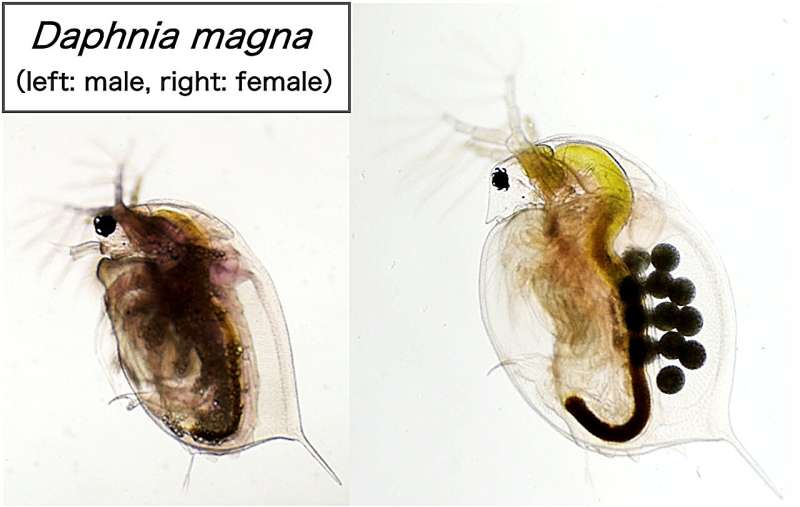This article has been reviewed according to Science X's editorial process and policies. Editors have highlighted the following attributes while ensuring the content's credibility:
fact-checked
peer-reviewed publication
trusted source
proofread
Researchers reveal how genetically identical water fleas develop into different sexes

Daphnia are tiny crustaceans, or "water fleas," that are extremely adaptable to their environment. This is due to their remarkable phenotypic plasticity, i.e., their ability to change their form or behavior despite their genetic makeup remaining unchanged. Even male and female Daphnia are genetically identical.
Now, a group at Osaka University has shed some light on this phenomenon, by combining two different RNA sequencing techniques to reveal that certain genes produce different versions, or isoforms, of the proteins they encode in male and female Daphnia.
Phenotypic plasticity allows a single genome to produce different "phenotypes," meaning Daphnia can physiologically adapt to variations in water salinity, temperature, the presence of predators, and more.
The article, "Identification of gene isoforms and their switching events between male and female embryos of the parthenogenetic crustacean Daphnia magna," was published in Scientific Reports.
A molecule called RNA is produced from a gene in a process called transcription, which provides instructions for the cellular machinery to then make the corresponding protein. Changes to the RNA after transcription can result in multiple isoforms, or slightly different RNA molecules, being produced from a single gene.
Such isoform variants are difficult to study because most RNA sequencing techniques read only very short stretches of RNA molecules, and then rely on computational techniques to piece the sequences back together. This means the fine details of different isoforms are lost.
However, in a novel approach, the team first used a newer, long-read RNA sequencing method called Iso-Seq to precisely identify all the different isoforms present in a species called Daphnia magna, before narrowing down the specific switching of isoforms occurring between males and females using highly accurate short-read RNA sequences.
"Short-read sequencing alone is unable to uncover this information," explains first author Yasuhiko Kato. "This novel approach, combining long- and short-read sequencing, reveals previously unknown nuances of Daphnia transcription."
"We identified genes that switch which specific isoforms are expressed in a sex-dependent manner," adds senior author Hajime Watanabe. "This provides insight into the biological mechanisms that underlie the unique phenotypic plasticity of Daphnia."
This research reveals the molecular basis for sexual dimorphism in Daphnia, an ecologically important species, and provides a tool for understanding how environmental conditions can determine sex in this species. These findings thus open the way for further advancements in crustacean aquaculture.
More information: Yasuhiko Kato et al, Identification of gene isoforms and their switching events between male and female embryos of the parthenogenetic crustacean Daphnia magna, Scientific Reports (2024). DOI: 10.1038/s41598-024-59774-1
Journal information: Scientific Reports
Provided by Osaka University


















